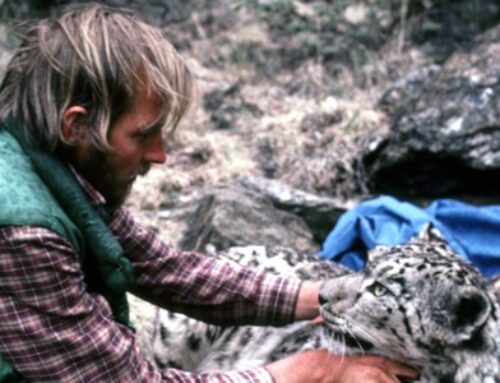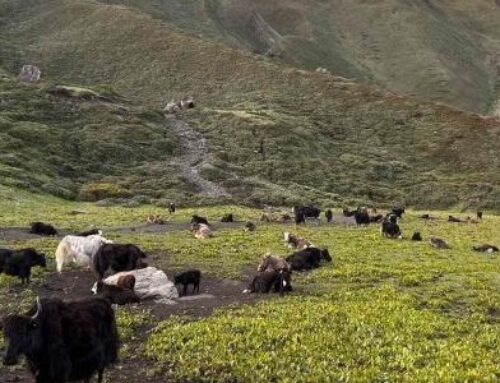Notes From The Field
By Kayley Bateman

Manang Valley, Nepal
As the first rays of sunlight illuminated the towering peaks of the Himalayas, I found myself awakening to the mesmerizing symphony of the Marshyangdi and Ghatte Khola rivers converging just beyond my teahouse. The significance of these rivers was not lost on me as they are two among many lifelines carved by the snowmelt of the mighty Himalayas. These rivers supply water for nearly half of the world’s population. It was a humbling thought as I stepped outside onto the narrow balcony of my rustic cottage. The air was thick with the unmistakable scent of juniper smoke, a daily ritual in the high mountains. The locals burned juniper as an offering to the mountain gods and as a method of purification, creating an atmosphere that felt both sacred and serene.
With each breath, I could feel the energy of Chame village coming to life. As I descended the precarious wooden stairs to the courtyard below, the panoramic views of Annapurna II slowly revealed themselves through the dissipating morning fog. The mountains stood tall and majestic, silent guardians of the valley. It was surreal to think that a mere two days earlier I was snugly tucked into a Bolero jeep with the rest of our veterinary team, navigating the winding roads that led me to this remote haven. The journey had been an adventure in itself, with every bump and turn of the road and bruise earned, a reminder of the rugged beauty that awaited at the end of our drive.

Local teahouse in Chame Village
As I stood there mesmerized, taking in the vast surroundings and reflecting on the journey of the past two days, I began to refocus my attention on our goal and mission for the next week. That morning marked the beginning of the One Health – One Welfare project, a collaborative endeavor uniting the efforts of the Snow Leopard Conservancy, International Veterinary Outreach, and our Nepali partners, Mountain Spirit and Animal Nepal. Together, we formed a dedicated team of wildlife professionals, veterinarians, and conservationists. I recalled the months leading up to our travel; I had immersed myself in understanding the foundation of our group’s mission, the One Health – One Welfare approach. We were finally here, ready to implement our strategy, a framework for conservation that uniquely bridges human, animal, and environmental health.
As I stood there mesmerized, taking in the vast surroundings and reflecting on the journey of the past two days, I began to refocus my attention on our goal and mission for the next week. That morning marked the beginning of the One Health – One Welfare project, a collaborative endeavor uniting the efforts of the Snow Leopard Conservancy, International Veterinary Outreach, and our Nepali partners, Mountain Spirit and Animal Nepal. Together, we formed a dedicated team of wildlife professionals, veterinarians, and conservationists. I recalled the months leading up to our travel; I had immersed myself in understanding the foundation of our group’s mission, the One Health – One Welfare approach. We were finally here, ready to implement our strategy, a framework for conservation that uniquely bridges human, animal, and environmental health.

Local teahouse in Chame Village

One Health – One Welfare Team in Pisang
Our team of 11 embarked on an eight-day trip to Nepal’s Annapurna Conservation Area for an outreach mission to strengthen local capacity and improve the lives of animals and people. Our primary goal was to train and bring resources to the local Junior Technicians (JTs) or paraveterinarians of Manang Valley. I learned that JTs are similar to veterinary technicians in the United States and provide direct veterinary care to livestock and other domestic animals within their home district. They also offer their community guidance and support on proper animal care and welfare. Partly due to the uniqueness of Manang Valley, JTs are often unprepared for managing the complex socio-ecological problems they encounter. The region is extremely remote, often lacking roads to high mountain villages, making it difficult and at times impossible to travel to animal patients. Besides roads, the high-mountain villages they serve lack other modern-day infrastructure, and residents have very limited access to basic resources. The JTs, themselves, only receive a basic education in their field, and opportunities for advanced learning are generally not available. Despite their limited training, JTs play a pivotal role in safeguarding human and animal health and managing animal welfare in their communities. As a result, there is a clear and urgent need to enhance the skills, knowledge, and overall capacity of these local leaders.
Our team of 11 embarked on an eight-day trip to Nepal’s Annapurna Conservation Area for an outreach mission to strengthen local capacity and improve the lives of animals and people. Our primary goal was to train and bring resources to the local Junior Technicians (JTs) or paraveterinarians of Manang Valley. I learned that JTs are similar to veterinary technicians in the United States and provide direct veterinary care to livestock and other domestic animals within their home district. They also offer their community guidance and support on proper animal care and welfare. Partly due to the uniqueness of Manang Valley, JTs are often unprepared for managing the complex socio-ecological problems they encounter. The region is extremely remote, often lacking roads to high mountain villages, making it difficult and at times impossible to travel to animal patients. Besides roads, the high-mountain villages they serve lack other modern-day infrastructure, and residents have very limited access to basic resources. The JTs, themselves, only receive a basic education in their field, and opportunities for advanced learning are generally not available. Despite their limited training, JTs play a pivotal role in safeguarding human and animal health and managing animal welfare in their communities. As a result, there is a clear and urgent need to enhance the skills, knowledge, and overall capacity of these local leaders.

One Health – One Welfare Team in Pisang
How does empowering the JTs of Manang Valley benefit snow leopards? As a conservationist and former animal care professional, with a strong connection to the environment, I already had a deep understanding of the delicate balance of our world and how everything is interconnected. I knew that the health and well-being of all living things are directly affected by the environment, just as the environment has a profound impact on the health, welfare, and livelihood of people and animals. In Manang Valley, these connections are vividly apparent. In this part of the world, people are heavily reliant on the environment and its resources, and livestock such as goats, sheep, cows, and yak are a primary source of income.

Stray dog in Manang
Due to the dependency on livestock, people and their animals are venturing deeper into snow leopard habitat. This has the potential to significantly degrade the landscape, deplete and displace prey species, and increase the risk of disease transmission to wildlife, domestic animals, and humans. Recently, I learned that one of the most significant threats to snow leopards in this area is canine distemper (CDV), a virus carried by dogs, which is transmissible to snow leopards and is often fatal to big cats. An outbreak of CDV that spills over into the wildlife population could be devastating to the endangered snow leopards of Manang Valley.
I was reminded of this as we walked the narrow streets of Chame to meet our Junior Technicians for the workshop’s first classroom session that morning. On the way, we passed many stray dogs, some displaying the characteristic signs of CDV—apparent neurological symptoms, poor mobility, and discharge from the eyes and nose. It was easy to see that if left unchecked, the dog population could become a vector for disease transmission to the local snow leopard population. Unfortunately, CDV is just one of the many nuanced threats snow leopards face. Realizing this, I recognized that our presence here in Nepal could help bridge many social and ecological issues, starting by empowering the people who work at this critical juncture.
The next three days we spent with the JTs were filled with educational lectures and engaging conversations, and both the JTs and the One Health team learned from one another. We began to forge a collaborative bond, exchanging insights and practical knowledge that enriched our collective understanding of the unique challenges faced by the local community and its wildlife. We explored a diverse curriculum, covering topics ranging from livestock medicine and preventative care to wild carnivore biology and snow leopard conservation, all in the stunning backdrop of Nepal’s Annapurna Conservation Area.

One Health – One Welfare Team and Junior Technician Participants
Observing the workshops unfold was a truly enlightening experience, revealing the evident dedication these young leaders have for animal care. Their commitment to expanding knowledge and refining skills was especially promising, a dedication that became even more apparent when we transitioned from the classroom to the field. After the scheduled classroom sessions, we held five days of animal clinics in the villages of Koto, Chame, Pisang, Braga, and Manang. Each day brought us to a different location where we encountered new patients, providing the JTs with hands-on training alongside our veterinary team. This practical experience allowed them to learn and develop new skills, enhancing their capabilities in their roles.

JTs observing and performing a hoof examination
During the following five days, our team attended to almost 250 animals. Our mobile clinic saw horses, mules, goats, sheep, cows, pigs, dogs, and cats, and at times, we were turning away patients due to the incredible response in the community. Each animal was examined, treated for various injuries or illnesses, and received the appropriate vaccinations. Every canine patient who was seen was vaccinated for CDV. The long days were characterized by bursts of intense activity, followed by quieter periods when no animal patients awaited attention. Amidst this, there were moments of delightful chaos, especially when we found ourselves momentarily overrun by mules or goats. These situations often led to comical scenes of JTs, herders, and veterinarians scrambling to restore order.
During the following five days, our team attended to almost 250 animals. Our mobile clinic saw horses, mules, goats, sheep, cows, pigs, dogs, and cats, and at times, we were turning away patients due to the incredible response in the community. Each animal was examined, treated for various injuries or illnesses, and received the appropriate vaccines. Every canine patient who was seen was vaccinated for CDV. The long days were characterized by bursts of intense activity, followed by quieter periods when no animal patients awaited attention. Amidst this, there were moments of delightful chaos, especially when we found ourselves momentarily overrun by mules or goats. These situations often led to comical scenes of JTs, herders, and veterinarians scrambling to restore order.

JTs observing and performing a hoof examination

Chame Equine Clinic
As each day unfolded, I could see how the JTs grew more self-assured in their abilities, gradually shouldering more responsibilities. By the conclusion of the clinic sessions, many JTs were independently handling cases, conducting examinations and assessments, and formulating their treatment plans. They would then collaborate with one of the veterinarians to finalize the treatment strategy, with the JT actively executing the majority of the care. This evolution showcased the remarkable progress and increasing autonomy these dedicated individuals achieved in a short span.

JTs performing an injection on an equid patient
What made the experience truly memorable for me was witnessing instances where theory transformed into reality for our JTs. It was inspiring to see the glow on the face of a JT who had just attempted a dental procedure or had just learned the process of inserting a nasogastric tube. Being part of a dynamic classroom where the JTs of Manang Valley were learning new skills to be well-prepared, frontline heroes for animal health and welfare felt extremely meaningful. I hoped that we left the JTs feeling more empowered with new skills and resources to serve the people and animals of Manang Valley and, in turn, support the conservation of snow leopards that share the magnificent landscape.
What made the experience truly memorable for me was witnessing instances where theory transformed into reality for our JTs. It was inspiring to see the glow on the face of a JT who had just attempted a dental procedure or had just learned the process of inserting a nasogastric tube. Being part of a dynamic classroom where the JTs of Manang Valley were learning new skills to be well-prepared, frontline heroes for animal health and welfare felt extremely meaningful. I hoped that we left the JTs feeling more empowered with new skills and resources to serve the people and animals of Manang Valley and, in turn, support the conservation of snow leopards that share the magnificent landscape.

JTs performing an injection on an equid patient
Our last day in the field was spent in Manang Village, a surprisingly bustling small outpost where many tourists begin trekking the Annapurna circuit. The village rests at over 11,000 feet, marking the highest elevation of our trip and the beginning of snow leopard habitat. During our final clinical workshop, I often caught myself gazing up at cliffs that seemed to engulf the sky around us. I could envision the “ghost of the mountains” staring back at me. The views were breathtaking, and the scenery was just as I had pictured. Being there, in snow leopard habitat, witnessing this landscape for the first time, was truly impactful. Surrounded by this incredible beauty and seeing first-hand the challenges this region faces, the significance of our work and mission became even more evident. However, what I experienced that final morning, really brought everything full circle.

Annapurna II and the “Ghost of the Mountains”
The morning we were scheduled to leave, a few members of our team and I decided to wake up early to explore the surrounding trails and venture deeper into snow leopard habitat. At sunrise, we hiked up the valley, tracing the river, crossing the iconic suspended footbridges and venturing into areas where I knew snow leopards had been spotted before—it was a profound and humbling experience just to walk in their territory. On our walk, our group was joined by a friendly stray dog from the village. Our new friend would trot ahead of our group by about 30 feet, then stop to wait for us. It was as if we had our very own local guide. We stopped on a plateau to rest and use our binoculars to scan for wildlife. We hoped that we would spot blue sheep, the favorite prey of snow leopards, or if incredibly lucky, the elusive cat itself. Unfortunately, after nearly an hour of scanning the cliff sides, we did not see any signs of wildlife and decided it was about time to turn around and head back to the village.

Kayley discovering sign of the snow leopard
As we headed back, our canine guide followed us, sticking closer to me as I was one of the last of the group making our way back down to the village–I didn’t feel quite ready to leave this amazing place. As I followed our new friend down the narrow trail, I watched as she stopped suddenly and began intently sniffing the flat surface under an overhanging rock next to the trail. A sense of curiosity gripped me, and after my companion concluded her investigation, I bent down to examine the area. To my amazement, I discovered two distinct, wet-looking patches on the rock—a clear indication of a snow leopard marking its territory!
My understanding of snow leopard behavior added a layer of personal significance to this discovery. Snow leopards are generally solitary creatures that communicate with other cats through scent marking, using urine to spray surfaces like rocks and scraping the earth with their back legs. This ritual leaves behind a unique scent that serves as a form of communication with other snow leopards. For me, discovering these markings felt like I was receiving a personal message directly from the “guardians of the high mountains.” While I do not possess the skills of interpretation, I could feel in my heart that the message was one of peace, love, and gratitude for our work and dedication to the wildlife and people of Manang Valley.
As we walked back to the village, my last moments in Manang Valley felt like the beginning of a new connection to the natural world. I realized my experience reinforced the meaningful and delicate connections between people, wildlife, and the environment, highlighting the importance of our mission in this unique and special place.

Kayley in Manang Valley





